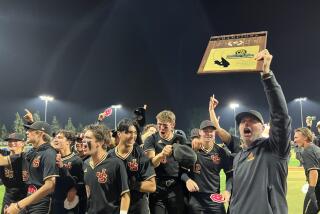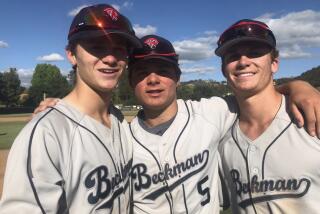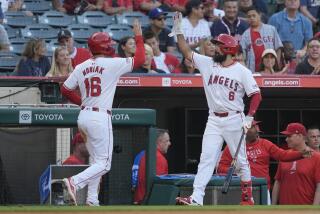Getting Caught in Draft Is an Occupational Hazard
Cal State Fullerton’s baseball season ended Sunday in a Game 3 super-regional loss to Arizona State that also concluded the Titans’ quest for a second consecutive national championship.
So now that Fullerton no longer is focusing on finishing No. 1, it can focus on another important number: 14.
That’s how many Titan players were selected last week in Major League Baseball’s amateur draft, tying the record set by Arizona State in 1982. The picks ranged from left-handed pitcher Ricky Romero, chosen sixth overall by the Toronto Blue Jays, to infielder Blake Davis, taken in the 46th round with the 1,377th pick by the Cleveland Indians.
In addition, five of Fullerton’s 10 recruits were drafted, including one chosen 34th overall.
Not every player selected is expected to sign a pro contract, but the sometimes unpredictable and prolonged negotiating phase that annually follows the draft leaves college baseball coaches scrambling to find players -- or scholarship money -- for the next season.
“There’s definitely some surprises after draft day,” Fullerton Coach George Horton said. “The worst surprises are later in the summer, when there’s not much you can do about it.”
Though it’s unlikely, Fullerton might have to replace six infielders, four outfielders, three pitchers and a catcher because of the draft. Or, in a situation that college coaches describe as equally trying, find room for recruits if current players who were projected to sign return for another season.
The guessing game is an annual rite of summer in college baseball because juniors and some sophomores are draft-eligible and the NCAA limits each school to a maximum equivalent of only 11.7 scholarships.
“You never know who you’re going to end up with,” Long Beach State Coach Mike Weathers said.
Some of the fallout after the draft is predictable.
Arizona, for example, signed Camarillo High outfielder Delmon Young to a letter of intent a few years ago knowing that Young would be a top draft pick and probably would turn pro. Young was chosen first overall by the Tampa Bay Devil Rays in 2003 and received a $3.7-million bonus, but Arizona traded on the cachet of having attracted such a top-flight prospect.
Last November, UCLA signed outfielder John Drennen of San Diego Rancho Bernardo High, who was regarded as a potential high-round pick. On Tuesday, the Cleveland Indians chose Drennen 33rd overall during the supplemental phase of the first round. He is expected to turn pro.
UCLA Coach John Savage says he attempts to recruit a mix of top prospects and less-heralded players so as not to be left with a huge void after the draft.
“You have to balance the books and say, ‘This guy’s a legitimate Pac-10 player. He doesn’t profile out to a five-tool big league player, but he can be a good college player,’ ” Savage said.
All major four-year programs, however, shoot for the stars.
Last fall, Fullerton recruited pitcher Ryan Tucker knowing he was a potential high-round pick. Tucker, a 6-foot-2, 190-pound right-hander from Temple City High, was chosen 34th by the Florida Marlins in the supplemental phase of the first round.
“We knew we’d probably never see him on campus,” Horton said before the draft. “But the other side of it is if you don’t get him to commit and someone else does, then shame on you for not taking him.”
Tucker said he kept Fullerton aware of his thoughts and plans as the draft approached. When it became clear that he would go very high, he said Fullerton coaches asked him if they could spend the scholarship money that had been allotted for him on other players. “I said, ‘Yeah, but if I decide to come to school, you have to make sure it’s still there,’ ” Tucker said.
USC, which was eliminated by Oregon State in a super-regional Monday, avoided a similar situation. The Trojans signed four players and -- in an unusual set of circumstances for USC -- none was drafted.
“They did what they said they would do -- say to pro people, ‘I’m going to school. If you’re not going to take me in the first or second round, don’t take me,’ ” USC Coach Mike Gillespie said.
But it doesn’t always work out that way.
Last year, for example, the Trojans received commitments from pitcher/shortstop Trevor Plouffe and pitcher/infielder Mark Trumbo, both projected as high-round picks. The Minnesota Twins chose Plouffe in the first round and signed him for a $1.5-million bonus. Trumbo was not chosen until the 18th round, by the Angels, because of his commitment to USC.
“When he went in the 18th round we were feeling pretty good,” Gillespie said.
The Angels, however, eventually offered Trumbo a $1.425-million bonus and he signed in August, leaving USC with a void.
“There wasn’t much to be found on August 25,” Gillespie said.
Trumbo’s scholarship money was distributed to other players.
“We ended up being Santa Claus to several guys in the program,” Gillespie said. “It was like Christmas in August.”
The situation created by the draft, however, is no holiday for coaches.
During the season, they attempt to stay abreast of what pro scouts think of their current players and recruits. The goal is to not get stuck having overcommitted their scholarship money.
“It’s probably one of the most miserable experiences you go through as a coach,” Arizona’s Andy Lopez said. “You hope like heck your guys have great years so your team does well and they can go on and start their careers.
“But if they falter, or they don’t sign, now you’re going, ‘Holy smoke, they’re coming back and we’ve just offered someone else their scholarship money.’ ”
Conversely, if players and recruits unexpectedly sign pro contracts, coaches turn to junior colleges, four-year college players taking advantage of the NCAA’s one-time transfer rule or previously overlooked high school players to supplement the roster.
“You try, with mixed results, to stay on top of who’s out there, who’s uncommitted, who’s slipped through cracks, who’s come on that nobody knew about,” Gillespie said.
Horton said the post-draft fallout does not have to be a painful process.
“What we ask is just be honest with us,” Horton said. “We don’t want to hear from a kid or his family that there’s no way we’re going to sign or it’ll take $200,000 to sign and then we hear back from the kid and he says, ‘Hey, Coach, I signed for $15,000.’
“If they want to sign, just tell us that. It buys us a few more days to go find someone else.”
*
Times staff writer Eric Stephens contributed to this report.
More to Read
Go beyond the scoreboard
Get the latest on L.A.'s teams in the daily Sports Report newsletter.
You may occasionally receive promotional content from the Los Angeles Times.











